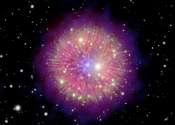Turbulence May Promote the Birth of Massive Stars
(PhysOrg.com) -- On long, dark winter nights, the constellation of Orion the Hunter dominates the sky. Within the Hunter's sword, the Orion Nebula swaddles a cluster of newborn stars called the Trapezium. These stars are ...








